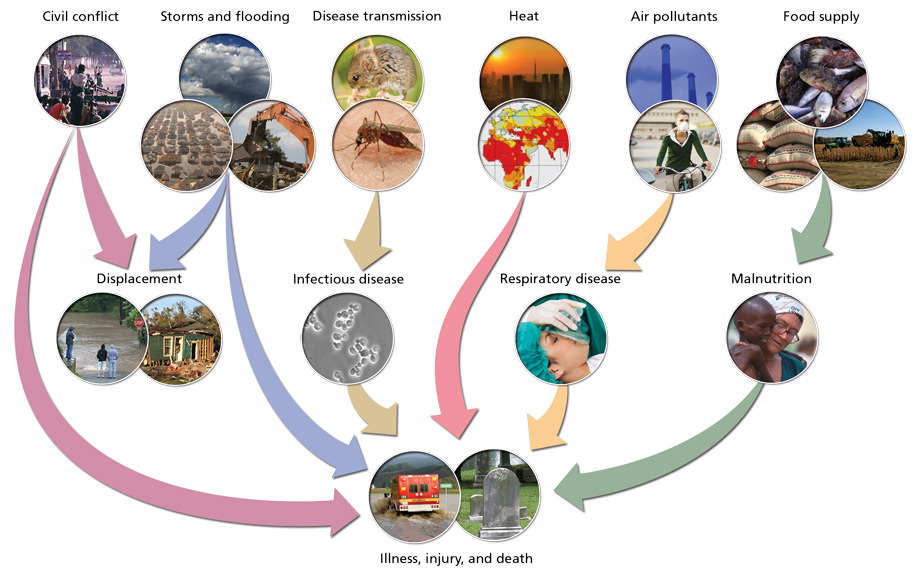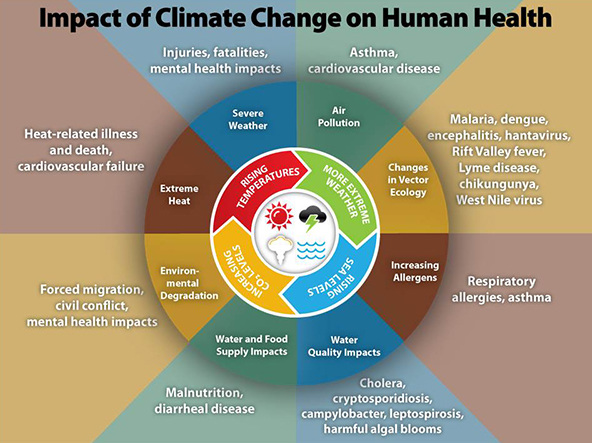|
One day a professor asked me, a chemist, “Why are you studying the environmental applications of chemistry if the biomedical and health sciences are more important, and there are more funding opportunities?” However, I started to reflect on it and realized that everything is a chain reaction. Whatever happens to the environment has a direct or indirect impact on our lifestyle, which includes our health. Climate Change affects the social and environmental determinants of our health such as clean air, safe drinking water, sufficient food, secure shelter and others [Figure 1]. The topic that I am most passionate is clean air. High temperatures raise the ground-level ozone concentrations, which can damage lung tissue, affect the respiratory system and reduce visibility by creating smog together with other pollutants. (The ground-level is the bad ozone, but the high-level ozone is a good one, which protects us from the sun.) Similarly, in extreme heat, pollen and other allergens concentrations are higher. The reduction of air quality is also due to the identity and concentration of aerosols. As I explained in my previous blog, the aerosols affect the climate and public health. Epidemiological studies have linked acute and chronic exposure to aerosol to increased morbidity & mortality, as well as to respiratory & cardiovascular diseases in the USA and Europe. The World Health Organization (WHO) estimates that in 2005 over 800,000 deaths occurred as a result of poor outdoor air quality. These deaths result from many pathways including respiratory infection, interference with lung function, asthma, cancers, cardiovascular disease, stroke, and developmental impairment in children. Recently, there is a lot of research regarding the air pollution and the reproduction.
Let's explore briefly the other factors. For example, increase in air temperatures will lead to hotter days and more frequent and longer heat waves, especially during the summers. The heat waves can lead to heart stroke and dehydration. High temperatures can also increase the food-borne diseases such as salmonella and other gastrointestinal distress. Another consequence of climate change it’s the extreme weather events. The rise of variable rainfall patterns will affect the supply of fresh water. The shortage of safe water can compromise hygiene. Also, the floods could contaminate those freshwater supplies, increasing the risk of water-borne disease, and create breeding grounds for disease-carrying insects such as mosquitoes. Water-borne diseases typically lead to gastroenteritis and multiple infections. Some animal-borne diseases sensitive to climate conditions are dengue, malaria, West Nile virus, etc. (I remembered how worry I was when my brother got dengue three times.) Moreover, another consequence could go the other way like droughts. (There is currently a drought in my hometown in Puerto Rico, which it is limiting the tap water supplies, obligating the people to adjust their lifestyle.) In general, all these factors (change in temperatures, precipitation, floods, and droughts) will likely affect agricultural yields and production. To continue the chain reaction, this could lead to socio-economical problems. For example, I invite you to analyze objectively the situation in Syria based on climate change and social sciences rather than purely in its political aspect. I want to end this with the picture below [Figure 2], a visual representation of the climate change implications on human health and its feedback loop.
1 Comment
hi
12/4/2018 03:51:33 pm
why doo
Reply
Leave a Reply. |
Categories
All
Archives
March 2024
|


 RSS Feed
RSS Feed
